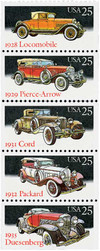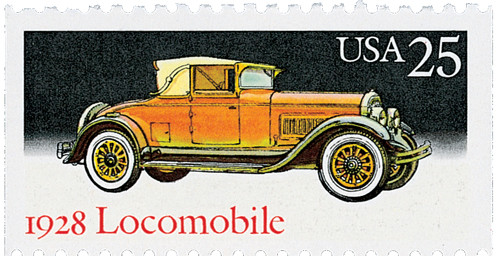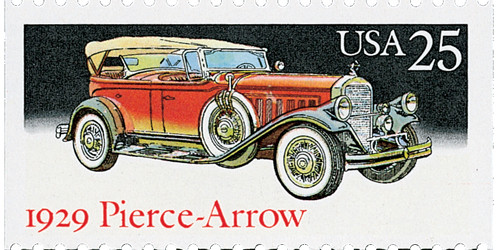
# 2381-85 - 1988 25c Classic Cars
U.S. #2381-85
1988 25¢ Classic Cars
5 Stamps
- Pictures 5 Classic Cars produced between 1925 and 1942
- Issued at STAMPSHOW ’88 in Detroit, Michigan
Stamp Category: Commemorative
Set: Classic Cars
Value: 25¢, first-class rate
First Day of Issue: August 25, 1988
First Day City: Detroit, Michigan
Quantity Issued: 127,047,000 booklet panes
Printed by: Bureau of Engraving and Printing
Printing Method: Lithographed and engraved
Format: 4 panes of 5 per booklet
Perforations: 10 horizontal on 1 or 2 sides
Why the stamps were issued: The years 1925 to 1942 are considered by many to be the age of the classic car. This booklet pane of five different designs features the "classiest of the classics" from that era.
About the stamp designs: Plans for a group of stamps honoring old American automobiles dates back to 1979. At the time it was proposed to be a se-tenant of four and two artists were commissioned to sketch their own blocks. Over time, some of the vehicles pictured on these stamps were used in the Transportation Series or other sets. Then the Citizens’ Stamp Advisory Committee decided to make this issue a booklet pane of five and tasked the Topic Subcommittee with producing a list of cars made by companies that weren’t still in operation. They came back with a list of 12 which was narrowed down to five.
Ken Dallison was hired to design these stamps. He had experience both in designing stamps and creating automotive art. Dallison received a list of the makes of cars and was permitted to select the model years he deemed best for artistic purposes. He created pen-and-ink-wash designs of each car based on archival and personal photos.
Special design details: All the cars in the pane face to the right, but progressively point from slightly to the side to straight ahead, to give a fanning effect to the booklet from top to bottom. Also, the tagging on each stamp was customed to fit the white space around each car.
First Day City: The First Day ceremony for the Classic Cars stamp booklet was held at Cobo Hall before STAMPSHOW ’88 in Detroit, Michigan, the Motor City. The show was the 102nd annual convention of the American Philatelic Society. Actual examples of each car were on display next to posters of the stamps.
History the stamps represent:
1928 Locomobile – The Locomobile, the oldest car in the set was built in Bridgeport, Connecticut, in 1928. The company began by making steam cars in 1899 and combined locomotive and automobile to get its name. They soon switched to gas-powered engines and luxury cars. Durant Motors bought out the company in 1922, which ran it until its production ended in 1929. The Locomobiles sold for almost $2,000 – equal to about $80,000 in today’s wages.
1929 Pierce-Arrow – George N. Pierce’s company started by manufacturing items like birdcages and bicycles. In 1904, they first produced the luxurious Arrow car, and it won an endurance race the following year. Pierce-Arrows became the favored cars for Presidents and Hollywood stars.
1931 Cord – “If you can’t be the biggest, it pays to be different,” was the philosophy of E.L. Cord was a mechanic, race car driver, and salesman who first made a name for himself in the automobile industry by turning around the struggling Auburn Automobile Company in the 1920s. He later ran other businesses such as Duesenberg, Inc., Checker Cabs, New York Shipbuilding, and American Airways. He realized he couldn’t compete with huge carmakers like Ford and General Motors, so he tried to build his own niche.
The result was some of the most luxurious cars of the time. Cord had been impressed with the front-wheel-drive performance he saw in a car at the 1925 Indianapolis 500 race. The front-wheel-drive design allowed for better handling on corners, but also for a car with a lower center of gravity – which enabled a sleeker, more stylish look.
With changes in appearance and performance, Cord began producing some of the most luxurious cars of the era. He gathered some of the most talented and artistic automotive engineers in the business and gave them the resources to experiment. The result was classic cars like the Cord L-29 model.
1932 Packard – In 1899, James Ward Packard wasn’t satisfied with his new car, so he wrote the company with his complaints. The owner suggested he build a better one himself – and he promptly did. That was the start of the Packard Motor Car Company. During the Great Depression of the 1930s, Packard sold luxury cars like the Packard Twelve, which it produced until 1939.
1935 Duesenberg – E.L. Cord (the same man who created the 1931 Cord in this set) was influential at Duesenberg. After taking control of the company in 1928, Cord worked with Fred Duesenberg to produce what would eventually become the Duesenberg Model J car.
The Duesenbergs already had a reputation for luxury and power. They were high-end machines, selling for nearly $20,000 each (about $250,000 in today’s dollars). Duesenbergs became the chosen car of the social elite, and were owned by famous people like Gary Cooper, Clark Gable, Howard Hughes, and European royalty.
The Great Depression put a halt to the production of many of the classic cars. People were less willing (or able) to spend huge amounts of money on luxury items. When Cord’s automobile empire finally collapsed in 1937, it marked the end of an era in luxury vehicles.
U.S. #2381-85
1988 25¢ Classic Cars
5 Stamps
- Pictures 5 Classic Cars produced between 1925 and 1942
- Issued at STAMPSHOW ’88 in Detroit, Michigan
Stamp Category: Commemorative
Set: Classic Cars
Value: 25¢, first-class rate
First Day of Issue: August 25, 1988
First Day City: Detroit, Michigan
Quantity Issued: 127,047,000 booklet panes
Printed by: Bureau of Engraving and Printing
Printing Method: Lithographed and engraved
Format: 4 panes of 5 per booklet
Perforations: 10 horizontal on 1 or 2 sides
Why the stamps were issued: The years 1925 to 1942 are considered by many to be the age of the classic car. This booklet pane of five different designs features the "classiest of the classics" from that era.
About the stamp designs: Plans for a group of stamps honoring old American automobiles dates back to 1979. At the time it was proposed to be a se-tenant of four and two artists were commissioned to sketch their own blocks. Over time, some of the vehicles pictured on these stamps were used in the Transportation Series or other sets. Then the Citizens’ Stamp Advisory Committee decided to make this issue a booklet pane of five and tasked the Topic Subcommittee with producing a list of cars made by companies that weren’t still in operation. They came back with a list of 12 which was narrowed down to five.
Ken Dallison was hired to design these stamps. He had experience both in designing stamps and creating automotive art. Dallison received a list of the makes of cars and was permitted to select the model years he deemed best for artistic purposes. He created pen-and-ink-wash designs of each car based on archival and personal photos.
Special design details: All the cars in the pane face to the right, but progressively point from slightly to the side to straight ahead, to give a fanning effect to the booklet from top to bottom. Also, the tagging on each stamp was customed to fit the white space around each car.
First Day City: The First Day ceremony for the Classic Cars stamp booklet was held at Cobo Hall before STAMPSHOW ’88 in Detroit, Michigan, the Motor City. The show was the 102nd annual convention of the American Philatelic Society. Actual examples of each car were on display next to posters of the stamps.
History the stamps represent:
1928 Locomobile – The Locomobile, the oldest car in the set was built in Bridgeport, Connecticut, in 1928. The company began by making steam cars in 1899 and combined locomotive and automobile to get its name. They soon switched to gas-powered engines and luxury cars. Durant Motors bought out the company in 1922, which ran it until its production ended in 1929. The Locomobiles sold for almost $2,000 – equal to about $80,000 in today’s wages.
1929 Pierce-Arrow – George N. Pierce’s company started by manufacturing items like birdcages and bicycles. In 1904, they first produced the luxurious Arrow car, and it won an endurance race the following year. Pierce-Arrows became the favored cars for Presidents and Hollywood stars.
1931 Cord – “If you can’t be the biggest, it pays to be different,” was the philosophy of E.L. Cord was a mechanic, race car driver, and salesman who first made a name for himself in the automobile industry by turning around the struggling Auburn Automobile Company in the 1920s. He later ran other businesses such as Duesenberg, Inc., Checker Cabs, New York Shipbuilding, and American Airways. He realized he couldn’t compete with huge carmakers like Ford and General Motors, so he tried to build his own niche.
The result was some of the most luxurious cars of the time. Cord had been impressed with the front-wheel-drive performance he saw in a car at the 1925 Indianapolis 500 race. The front-wheel-drive design allowed for better handling on corners, but also for a car with a lower center of gravity – which enabled a sleeker, more stylish look.
With changes in appearance and performance, Cord began producing some of the most luxurious cars of the era. He gathered some of the most talented and artistic automotive engineers in the business and gave them the resources to experiment. The result was classic cars like the Cord L-29 model.
1932 Packard – In 1899, James Ward Packard wasn’t satisfied with his new car, so he wrote the company with his complaints. The owner suggested he build a better one himself – and he promptly did. That was the start of the Packard Motor Car Company. During the Great Depression of the 1930s, Packard sold luxury cars like the Packard Twelve, which it produced until 1939.
1935 Duesenberg – E.L. Cord (the same man who created the 1931 Cord in this set) was influential at Duesenberg. After taking control of the company in 1928, Cord worked with Fred Duesenberg to produce what would eventually become the Duesenberg Model J car.
The Duesenbergs already had a reputation for luxury and power. They were high-end machines, selling for nearly $20,000 each (about $250,000 in today’s dollars). Duesenbergs became the chosen car of the social elite, and were owned by famous people like Gary Cooper, Clark Gable, Howard Hughes, and European royalty.
The Great Depression put a halt to the production of many of the classic cars. People were less willing (or able) to spend huge amounts of money on luxury items. When Cord’s automobile empire finally collapsed in 1937, it marked the end of an era in luxury vehicles.














